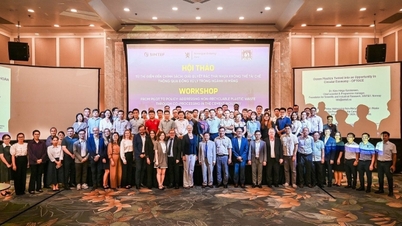 |
| Chinese scientists are researching and finding tools to accurately predict upcoming large-scale earthquakes around the world . (Source: SCMP) |
About 84 hours before a 7.2-magnitude earthquake struck off the coast of Alaska on July 16, a team of researchers in China predicted an impending quake but could not pinpoint the exact time and location.
The team now hopes to continue expanding the research network to make more accurate earthquake predictions.
Big step forward
Zhang Maosheng, a professor and dean at Xian Jiaotong University in Shaanxi Province and a researcher with China's Ministry of Natural Resources, received a notice of the unusual data a few days earlier.
His team is still unable to predict the full information, including magnitude, location, and timing, but they believe that discoveries after 10 years of monitoring data on earthquakes can get closer to this goal in the near future.
In a paper published in the Northwest China Journal of Geology in June, the team said it had spent more than a decade measuring the warning signs of an earthquake.
Using high-precision gravimeters, the team has collected data from dozens of earthquakes since 2010, including the massive earthquake that devastated Türkiye-Syria on February 6.
The paper presents a method for monitoring the Earth's gravitational field at low frequencies that could be a potential indicator for predicting imminent or high-intensity earthquakes.
According to the United States Geological Survey (USGS), “harbingers” of a large-scale earthquake can come from unusual events such as a series of small earthquakes or from unusual animal activity.
By monitoring changes in dynamic gravity, the team stumbled upon a reliable signature and potential four-phase mechanism that signals imminent earthquakes in the short term.
Particularly during the second phase or “locked energy storage” phase – which usually occurs between 1 and 15 days before an earthquake occurs – dynamic gravity anomalies are manifested through gravity peaks.
The team observed the anomalies using gravimeters, instruments that measure changes in Earth's absolute gravitational pull.
Scientists have developed a special dynamic gravimeter to measure abnormalities based on fluid movement. The tool is said to be more accurate in predicting short-term earthquakes, while also being more cost-effective.
Anomalous readings from this instrument were observed 83 hours before the magnitude 7.4 earthquake in Sulawesi, Indonesia, in September 2018 and 116 hours before the magnitude 7.2 earthquake in Tajikistan in February 2023.
The team said they have consistently seen signs of major earthquakes days before they occur, and for earthquakes with a magnitude above 7, “the accuracy is up to 100%,” according to Professor Zhang Maosheng.
Important scientific discoveries
Earthquake prediction has been paid attention by Chinese scientists since the 1950s and focused on practical research in the 1970s, some predicted earthquakes helped to significantly reduce casualties.
However, failures in predicting large-scale earthquakes have discouraged scientists in many countries.
According to Professor Liu Huaqing from Northwestern Polytechnical University in Xi'an, Shaanxi Province, many scientists in countries like the US or Japan do not believe it is possible to predict earthquakes, but “Chinese scientists do not agree with this view.”
The team began independently observing dynamic gravity data after noticing a link between unusual readings and earthquakes.
In the paper, the team shared a log of chat messages, including those sent five days before the Tajikistan earthquake. The team read the unusual results and made a prediction that a large-scale earthquake could occur in the next three days.
Notably, the Türkiye-Syria earthquake disaster that occurred earlier this year was also one of the 11 earthquakes observed by the research team. Accordingly, they saw two anomalous gravity peaks occurring one after another.
“We have never seen anything like this before. That day, after the initial 7.8 magnitude earthquake, there was a 7.5 magnitude earthquake,” Professor Zhang Maosheng recalled, adding that the research team could not have predicted that there would be two consecutive earthquakes.
Professor Zhang Maosheng said that further observations are needed to find the connection between earthquakes and gravity peak indices because dynamic gravity abnormalities often occur continuously for a period of time before an earthquake.
The expert added that the ability to predict earthquakes within a range of 1 to 15 days is “very accurate” and far exceeds the achievements in earthquake forecasting research of the global scientific community today.
The biggest challenge the team faces is using the information gathered from the sensors to establish the exact time and location of the earthquakes. In addition, the coverage of the devices is quite limited, with the team currently only having four facilities in Xi'an.
The group's goal is to work with researchers and countries to set up gravity meters around the world to create a network that covers and collects data.
“If it receives attention from scientists around the world and proves effective in many places, this will be a very important scientific discovery for earthquake prediction,” said Professor of Geology Yue Zhongqi of the University of Hong Kong (China).
Source






![[Photo] Prime Minister Pham Minh Chinh launched a peak emulation campaign to achieve achievements in celebration of the 14th National Party Congress](https://vphoto.vietnam.vn/thumb/1200x675/vietnam/resource/IMAGE/2025/10/5/8869ec5cdbc740f58fbf2ae73f065076)
![[Photo] Prime Minister Pham Minh Chinh chairs the Government's online conference with localities](https://vphoto.vietnam.vn/thumb/1200x675/vietnam/resource/IMAGE/2025/10/5/264793cfb4404c63a701d235ff43e1bd)






















































![[VIDEO] Summary of Petrovietnam's 50th Anniversary Ceremony](https://vphoto.vietnam.vn/thumb/402x226/vietnam/resource/IMAGE/2025/10/4/abe133bdb8114793a16d4fe3e5bd0f12)

![[VIDEO] GENERAL SECRETARY TO LAM AWARDS PETROVIETNAM 8 GOLDEN WORDS: "PIONEER - EXCELLENT - SUSTAINABLE - GLOBAL"](https://vphoto.vietnam.vn/thumb/402x226/vietnam/resource/IMAGE/2025/7/23/c2fdb48863e846cfa9fb8e6ea9cf44e7)



































Comment (0)